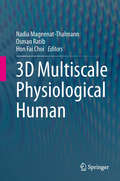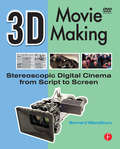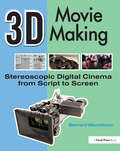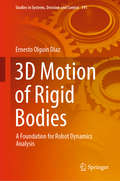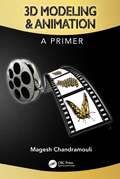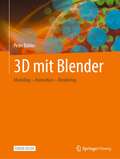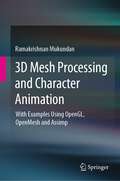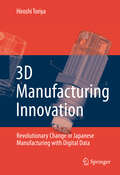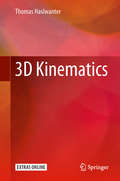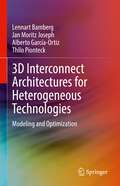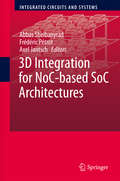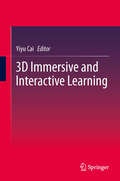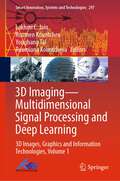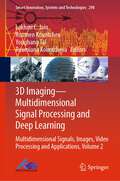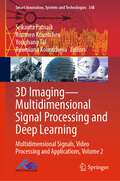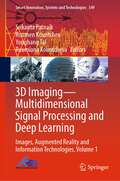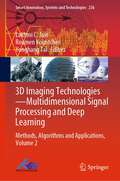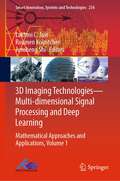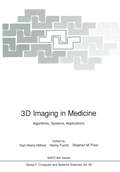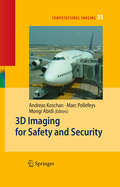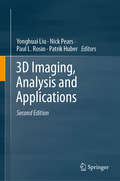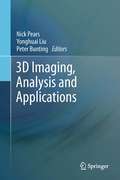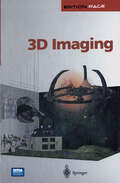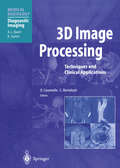- Table View
- List View
3D Multiscale Physiological Human
by Nadia Magnenat-Thalmann Osman Ratib Hon Fai Choi3D Multiscale Physiological Human aims to promote scientific exchange by bringing together overviews and examples of recent scientific and technological advancements across a wide range of research disciplines. As a result, the variety in methodologies and knowledge paradigms are contrasted, revealing potential gaps and opportunities for integration. Chapters have been contributed by selected authors in the relevant domains of tissue engineering, medical image acquisition and processing, visualization, modeling, computer aided diagnosis and knowledge management. The multi-scale and multi-disciplinary research aspects of articulations in humans are highlighted, with a particular emphasis on medical diagnosis and treatment of musculoskeletal diseases and related disorders.The need for multi-scale modalities and multi-disciplinary research is an emerging paradigm in the search for a better biological and medical understanding of the human musculoskeletal system. This is particularly motivated by the increasing socio-economic burden of disability and musculoskeletal diseases, especially in the increasing population of elderly people. Human movement is generated through a complex web of interactions between embedded physiological systems on different spatiotemporal scales, ranging from the molecular to the organ level. Much research is dedicated to the understanding of each of these systems, using methods and modalities tailored for each scale. Nevertheless, combining knowledge from different perspectives opens new venues of scientific thinking and stimulates innovation. Integration of this mosaic of multifaceted data across multiple scales and modalities requires further exploration of methods in simulations and visualization to obtain a comprehensive synthesis. However, this integrative approach cannot be achieved without a broad appreciation for the multiple research disciplines involved.
3D Movie Making: Stereoscopic Digital Cinema from Script to Screen
by Bernard MendiburuHollywood is going 3D, read this book to understand why and how, and to secure your next job on a 3D movie. Making a 3D movie is much more than shooting with a 3D camera and showing it in a 3D theater. Each and every step of the movie production cycle will be affected by 3D, just like sound and color affected the whole industry. After an introduction on how the human brain perceive depth, this book explains, in a step-by-step approach, how 3D affects screen writing, art direction, principal photography, editing, visual effects and even movies distribution. It's a must read for anyone in the profession who wants to understand the next revolution in cinema. The DVD is not included with the E-book. Please contact the publisher for access to the DVD content by emailing d.mcgonagle@elsevier.com.
3D Movie Making: Stereoscopic Digital Cinema from Script to Screen
by Bernard MendiburuHollywood is going 3D, read this book to understand why and how, and to secure your next job on a 3D movie. Making a 3D movie is much more than shooting with a 3D camera and showing it in a 3D theater. Each and every step of the movie production cycle will be affected by 3D, just like sound and color affected the whole industry. After an introduction on how the human brain perceive depth, this book explains, in a step-by-step approach, how 3D affects screen writing, art direction, principal photography, editing, visual effects and even movies distribution. It's a must read for anyone in the profession who wants to understand the next revolution in cinema. The DVD is not included with the E-book. Please contact the publisher for access to the DVD content by emailing d.mcgonagle@elsevier.com.
3D Motion of Rigid Bodies: A Foundation for Robot Dynamics Analysis (Studies in Systems, Decision and Control #191)
by Ernesto Olguín DíazThis book offers an excellent complementary text for an advanced course on the modelling and dynamic analysis of multi-body mechanical systems, and provides readers an in-depth understanding of the modelling and control of robots. While the Lagrangian formulation is well suited to multi-body systems, its physical meaning becomes paradoxically complicated for single rigid bodies. Yet the most advanced numerical methods rely on the physics of these single rigid bodies, whose dynamic is then given among multiple formulations by the set of the Newton–Euler equations in any of their multiple expression forms. This book presents a range of simple tools to express in succinct form the dynamic equation for the motion of a single rigid body, either free motion (6-dimension), such as that of any free space navigation robot or constrained motion (less than 6-dimension), such as that of ground or surface vehicles. In the process, the book also explains the equivalences of (and differences between) the different formulations.
3D Modeling & Animation: A Primer
by Magesh Chandramouli"If I were still teaching introductory computer graphics, I would not hesitate to use this textbook as it has just the right amount of coverage of the topic for a semester course and is presented in a highly appealing manner to engage the reader." – Gary Bertoline, PhD, Distinguished Professor of Computer Graphics Technology, Purdue University, USA Graphics-based 3D modeling and animation are relevant not only in the motion picture and video game industry, but also in many other disciplines including creative arts, engineering, architecture, education, medicine, etc. Understanding the basics of 3D modeling, and animation requires understanding some basic concepts in physics and math. While some books assume readers’ prior knowledge of these concepts, 3D Modeling & Animation: A Primer explains these important concepts in a visually engaging manner. This book is not just for university students, but for anyone with an interest in computer graphics modeling and animation. Using a Software-Agnostic approach, this book focuses on modeling and animation concepts spanning across multiple software platforms. Employing a balanced approach that is neither too technical nor too artistic, this book instills the need for creativity and visual composition in animation. KEY FEATURES: • Uses a simple, clear, and concise approach to explain the basics of modeling and animation • Two hundred plus vibrant images to easily understand and appreciate complex concepts • Review questions at chapter ends to help readers better review the content AUTHOR: Magesh Chandramouli is a Professor of Computer Graphics Technology at Purdue University Northwest and is a Distinguished Visiting Faculty of Computer Graphics at Feng Chia University, Taiwan. He is currently serving as the Director of Programs of the Engineering Design Graphics Division of the American Society for Engineering Education. He was a Frederick Andrews Fellow at Purdue University, West Lafayette, where he completed his PhD. He received Master of Science from the University of Calgary, Canada; Master of Engineering from the National University of Singapore; and B.E. from College of Engineering, Guindy, India. He has received National and International awards for his scholarly accomplishments and has delivered invited lectures in reputed universities and research centers around the world.
3D Modeling & Animation: A Primer
by Magesh Chandramouli"If I were still teaching introductory computer graphics, I would not hesitate to use this textbook as it has just the right amount of coverage of the topic for a semester course and is presented in a highly appealing manner to engage the reader." – Gary Bertoline, PhD, Distinguished Professor of Computer Graphics Technology, Purdue University, USA Graphics-based 3D modeling and animation are relevant not only in the motion picture and video game industry, but also in many other disciplines including creative arts, engineering, architecture, education, medicine, etc. Understanding the basics of 3D modeling, and animation requires understanding some basic concepts in physics and math. While some books assume readers’ prior knowledge of these concepts, 3D Modeling & Animation: A Primer explains these important concepts in a visually engaging manner. This book is not just for university students, but for anyone with an interest in computer graphics modeling and animation. Using a Software-Agnostic approach, this book focuses on modeling and animation concepts spanning across multiple software platforms. Employing a balanced approach that is neither too technical nor too artistic, this book instills the need for creativity and visual composition in animation. KEY FEATURES: • Uses a simple, clear, and concise approach to explain the basics of modeling and animation • Two hundred plus vibrant images to easily understand and appreciate complex concepts • Review questions at chapter ends to help readers better review the content AUTHOR: Magesh Chandramouli is a Professor of Computer Graphics Technology at Purdue University Northwest and is a Distinguished Visiting Faculty of Computer Graphics at Feng Chia University, Taiwan. He is currently serving as the Director of Programs of the Engineering Design Graphics Division of the American Society for Engineering Education. He was a Frederick Andrews Fellow at Purdue University, West Lafayette, where he completed his PhD. He received Master of Science from the University of Calgary, Canada; Master of Engineering from the National University of Singapore; and B.E. from College of Engineering, Guindy, India. He has received National and International awards for his scholarly accomplishments and has delivered invited lectures in reputed universities and research centers around the world.
3D mit Blender: Modeling – Animation – Rendering
by Peter BühlerDieses Buch ist der ideale Einstieg in die 3D-Modellierung und 3D-Animation mit dem Open-Source-Programm Blender. Anhand von Übungen mit leicht nachzuvollziehenden Schritt-für-Schritt-Anleitungen vermittelt es kompakt die wesentlichen Grundlagen der Arbeit mit Blender. Dank des durchdachten didaktischen Konzepts werden Ihnen Arbeitsschritte und Projektergebnisse praxisorientiert nähergebracht. Alle Anleitungen werden durchgängig mit hilfreichen Screenshots veranschaulicht. Nie war der Einstieg in Blender einfacher! Mit diesem Buch erhalten Sie eine fundierte Basis für die weitergehende Arbeit mit Blender.
3D Mesh Processing and Character Animation: With Examples Using OpenGL, OpenMesh and Assimp
by Ramakrishnan Mukundan3D Mesh Processing and Character Animation focusses specifically on topics that are important in three-dimensional modelling, surface design and real-time character animation. It provides an in-depth coverage of data structures and popular methods used in geometry processing, keyframe and inverse kinematics animations and shader based processing of mesh objects. It also introduces two powerful and versatile libraries, OpenMesh and Assimp, and demonstrates their usefulness through implementations of a wide range of algorithms in mesh processing and character animation respectively. This Textbook is written for students at an advanced undergraduate or postgraduate level who are interested in the study and development of graphics algorithms for three-dimensional mesh modeling and analysis, and animations of rigged character models. The key topics covered in the book are mesh data structures for processing adjacency queries, simplification and subdivision algorithms, mesh parameterization methods, 3D mesh morphing, skeletal animation, motion capture data, scene graphs, quaternions, inverse kinematics algorithms, OpenGL-4 tessellation and geometry shaders, geometry processing and terrain rendering.
3D Manufacturing Innovation: Revolutionary Change in Japanese Manufacturing with Digital Data
by Hiroshi ToriyaFor a company to survive in the manufacturing industry, it must not only accumulate light-weight 3D data, but also share this information within the company and with related companies as well as train key personnel. 3D Manufacturing Innovation introduces the best practices developed by Toyota, Sony, Nikon, Casio and other pioneers in the global engineering scene, providing the reader with invaluable tips for manufacturing innovation.
3D Kinematics
by Thomas HaslwanterThis book presents an introduction to the analysis of general movements in 3D space, especially for movements of the human body. It is based on the lecture notes of a class on 3D Kinematics, which the author has been holding in the Master Degree Program of his home institution, the University of Applied Sciences Upper Austria. The lecture introduces the mathematics underlying the measurement and analysis of 3D movements. The target audience primarily comprises research experts in the field, but the book may also be beneficial for graduate students alike.
3D Interconnect Architectures for Heterogeneous Technologies: Modeling and Optimization
by Lennart Bamberg Jan Moritz Joseph Alberto García-Ortiz Thilo PionteckThis book describes the first comprehensive approach to the optimization of interconnect architectures in 3D systems on chips (SoCs), specially addressing the challenges and opportunities arising from heterogeneous integration. Readers learn about the physical implications of using heterogeneous 3D technologies for SoC integration, while also learning to maximize the 3D-technology gains, through a physical-effect-aware architecture design. The book provides a deep theoretical background covering all abstraction-levels needed to research and architect tomorrow’s 3D-integrated circuits, an extensive set of optimization methods (for power, performance, area, and yield), as well as an open-source optimization and simulation framework for fast exploration of novel designs.
3D Integration for NoC-based SoC Architectures (Integrated Circuits and Systems)
by Abbas Sheibanyrad Frédéric Pétrot Axel JantschThis book presents the research challenges that are due to the introduction of the 3rd dimension in chips for researchers and covers the whole architectural design approach for 3D-SoCs. Nowadays the 3D-Integration technologies, 3D-Design techniques, and 3D-Architectures are emerging as interesting, truly hot, broad topics. The present book gathers the recent advances in the whole domain by renowned experts in the field to build a comprehensive and consistent book around the hot topics of three-dimensional architectures and micro-architectures. This book includes contributions from high level international teams working in this field.
3D Immersive and Interactive Learning
by Yiyu Cai3D technology is not new; research on 3D started back in early 1960s. But unlike in previous times, 3D technology has now rapidly entered our daily life from cinema to office to home. Using 3D for education is a new yet challenging task. This book will present several innovative efforts using 3D for immersive and interactive learning covering a wide spectrum of education including gifted program, normal (technical) stream, and special needs education. The book will also share experience on curriculum-based 3D learning in classroom setting and co-curriculum-based 3D student research projects. The book is organized as follows. Chapter 1 introduces the fundamentals of 3D educational technology and their applications in immersive and interactive learning. Chapter 2 discusses the use of virtual reality in teaching and learning of Molecular Biology. Chapter 3 presents the daVinci Lab @ River Valley High School. Chapter 4 describes the 3D education development process. Chapter 5 studies the adaption 3D system for learning gains in lower secondary normal (technical) stream. Chapter 6 investigates the effects of virtual reality technology on spatial visualization skills. Chapter 7 showcases a sabbatical program for students to use 3D for Science, Technology, Engineering and Mathematics (STEM) learning. Chapter 8 shares the use of 3D virtual pink dolphin to assist special education. The foreword of this book is written by Dr Cheah Horn Mun, Director, Education Technology Division, Ministry of Education, Singapore.
3D Imaging—Multidimensional Signal Processing and Deep Learning: 3D Images, Graphics and Information Technologies, Volume 1 (Smart Innovation, Systems and Technologies #297)
by Lakhmi C. Jain Roumen Kountchev Yonghang Tai Roumiana KountchevaThis book gathers selected papers presented at the conference “Advances in 3D Image and Graphics Representation, Analysis, Computing and Information Technology,” one of the first initiatives devoted to the problems of 3D imaging in all contemporary scientific and application areas. The two volumes of the book cover wide area of the aspects of the contemporary multidimensional imaging and outline the related future trends from data acquisition to real-world applications based on new techniques and theoretical approaches. This volume contains papers devoted to the theoretical representation and analysis of the 3D images. The related topics included are 3D image transformation, 3D tensor image representation, 3D content generation technologies, 3D graphic information processing, VR content generation technologies, multi-dimensional image processing, dynamic and auxiliary 3D displays, VR/AR/MR device, VR camera technologies, 3D imaging technologies and applications, 3D computer vision, 3D video communications, 3D medical images processing and analysis, 3D remote sensing images and systems, deep learning for image restoration and recognition, neural networks for MD image processing, etc.
3D Imaging—Multidimensional Signal Processing and Deep Learning: Multidimensional Signals, Images, Video Processing and Applications, Volume 2 (Smart Innovation, Systems and Technologies #298)
by Lakhmi C. Jain Roumen Kountchev Yonghang Tai Roumiana KountchevaThis book gathers selected papers presented at the conference “Advances in 3D Image and Graphics Representation, Analysis, Computing and Information Technology,” one of the first initiatives devoted to the problems of 3D imaging in all contemporary scientific and application areas. The two volumes of the book cover wide area of the aspects of the contemporary multidimensional imaging and outline the related future trends from data acquisition to real-world applications based on new techniques and theoretical approaches. This volume contains papers aimed at the multidimensional systems and signal processing, deep learning, mathematical approaches and the related applications. The related topics are multidimensional multi-component image processing; multidimensional image representation and super-resolution; compression of multidimensional spatio-temporal images; multidimensional image transmission systems; multidimensional signal processing; prediction and filtering of multidimensional process; intelligent multi-spectral and hyper-spectral image processing, intelligent multi-view image processing, 3D deep learning, 3D GIS and graphic database; data-based MD image retrieval and knowledge data mining; watermarking, hiding and encryption of MD images; intelligent visualization of MD images; forensic analysis systems for M3D graphics algorithm; 3D VR (Virtual Reality)/AR (Augmented Reality); applications of multidimensional signal processing; applications of multidimensional systems; multidimensional filters and filter-banks.
3D Imaging—Multidimensional Signal Processing and Deep Learning: Multidimensional Signals, Video Processing and Applications, Volume 2 (Smart Innovation, Systems and Technologies #348)
by Srikanta Patnaik Roumen Kountchev Yonghang Tai Roumiana KountchevaThis book presents high-quality research in the field of 3D imaging technology. The fourth edition of International Conference on 3D Imaging Technology (3DDIT-MSP&DL) continues the good traditions already established by the first three editions of the conference to provide a wide scientific forum for researchers, academia and practitioners to exchange newest ideas and recent achievements in all aspects of image processing and analysis, together with their contemporary applications. The conference proceedings are published in 2 volumes. The main topics of the papers comprise famous trends as: 3D image representation, 3D image technology, 3D images and graphics, and computing and 3D information technology. In these proceedings, special attention is paid at the 3D tensor image representation, the 3D content generation technologies, big data analysis, and also deep learning, artificial intelligence, the 3D image analysis and video understanding, the 3D virtual and augmented reality, and many related areas. The first volume contains papers in 3D image processing, transforms and technologies. The second volume is about computing and information technologies, computer images and graphics and related applications. The two volumes of the book cover a wide area of the aspects of the contemporary multidimensional imaging and the related future trends from data acquisition to real-world applications based on various techniques and theoretical approaches.
3D Imaging—Multidimensional Signal Processing and Deep Learning: Images, Augmented Reality and Information Technologies, Volume 1 (Smart Innovation, Systems and Technologies #349)
by Srikanta Patnaik Roumen Kountchev Yonghang Tai Roumiana KountchevaThis book presents high-quality research in the field of 3D imaging technology. The fourth edition of International Conference on 3D Imaging Technology (3DDIT-MSP&DL) continues the good traditions already established by the first three editions of the conference to provide a wide scientific forum for researchers, academia, and practitioners to exchange newest ideas and recent achievements in all aspects of image processing and analysis, together with their contemporary applications. The conference proceedings are published in two volumes. The main topics of the papers comprise famous trends as: 3D image representation, 3D image technology, 3D images and graphics, and computing and 3D information technology. In these proceedings, special attention is paid at the 3D tensor image representation, the 3D content generation technologies, big data analysis, and also deep learning, artificial intelligence, the 3D image analysis and video understanding, the 3D virtual and augmented reality, and many related areas. The first volume contains papers in 3D image processing, transforms, and technologies. The second volume is about computing and information technologies, computer images and graphics and related applications. The two volumes of the book cover a wide area of the aspects of the contemporary multidimensional imaging and the related future trends from data acquisition to real-world applications based on various techniques and theoretical approaches.
3D Imaging Technologies—Multidimensional Signal Processing and Deep Learning: Methods, Algorithms and Applications, Volume 2 (Smart Innovation, Systems and Technologies #236)
by Lakhmi C. Jain Roumen Kountchev Yonghang TaiThis book presents high-quality research in the field of 3D imaging technology. The second edition of International Conference on 3D Imaging Technology (3DDIT-MSP&DL) continues the good traditions already established by the first 3DIT conference (IC3DIT2019) to provide a wide scientific forum for researchers, academia and practitioners to exchange newest ideas and recent achievements in all aspects of image processing and analysis, together with their contemporary applications. The conference proceedings are published in 2 volumes. The main topics of the papers comprise famous trends as: 3D image representation, 3D image technology, 3D images and graphics, and computing and 3D information technology. In these proceedings, special attention is paid at the 3D tensor image representation, the 3D content generation technologies, big data analysis, and also deep learning, artificial intelligence, the 3D image analysis and video understanding, the 3D virtual and augmented reality, and many related areas. The first volume contains papers in 3D image processing, transforms and technologies. The second volume is about computing and information technologies, computer images and graphics and related applications. The two volumes of the book cover a wide area of the aspects of the contemporary multidimensional imaging and the related future trends from data acquisition to real-world applications based on various techniques and theoretical approaches.
3D Imaging Technologies—Multi-dimensional Signal Processing and Deep Learning: Mathematical Approaches and Applications, Volume 1 (Smart Innovation, Systems and Technologies #234)
by Lakhmi C. Jain Roumen Kountchev Junsheng ShiThis book presents high-quality research in the field of 3D imaging technology. The second edition of International Conference on 3D Imaging Technology (3DDIT-MSP&DL) continues the good traditions already established by the first 3DIT conference (IC3DIT2019) to provide a wide scientific forum for researchers, academia and practitioners to exchange newest ideas and recent achievements in all aspects of image processing and analysis, together with their contemporary applications. The conference proceedings are published in 2 volumes. The main topics of the papers comprise famous trends as: 3D image representation, 3D image technology, 3D images and graphics, and computing and 3D information technology. In these proceedings, special attention is paid at the 3D tensor image representation, the 3D content generation technologies, big data analysis, and also deep learning, artificial intelligence, the 3D image analysis and video understanding, the 3D virtual and augmented reality, and many related areas. The first volume contains papers in 3D image processing, transforms and technologies. The second volume is about computing and information technologies, computer images and graphics and related applications. The two volumes of the book cover a wide area of the aspects of the contemporary multidimensional imaging and the related future trends from data acquisition to real-world applications based on various techniques and theoretical approaches.
3D Imaging in Medicine: Algorithms, Systems, Applications (NATO ASI Subseries F: #60)
by Karl H. Höhne Henry Fuchs Stephen M. PizerThe visualization of human anatomy for diagnostic, therapeutic, and educational pur poses has long been a challenge for scientists and artists. In vivo medical imaging could not be introduced until the discovery of X-rays by Wilhelm Conrad ROntgen in 1895. With the early medical imaging techniques which are still in use today, the three-dimensional reality of the human body can only be visualized in two-dimensional projections or cross-sections. Recently, biomedical engineering and computer science have begun to offer the potential of producing natural three-dimensional views of the human anatomy of living subjects. For a broad application of such technology, many scientific and engineering problems still have to be solved. In order to stimulate progress, the NATO Advanced Research Workshop in Travemiinde, West Germany, from June 25 to 29 was organized. It brought together approximately 50 experts in 3D-medical imaging from allover the world. Among the list of topics image acquisition was addressed first, since its quality decisively influences the quality of the 3D-images. For 3D-image generation - in distinction to 2D imaging - a decision has to be made as to which objects contained in the data set are to be visualized. Therefore special emphasis was laid on methods of object definition. For the final visualization of the segmented objects a large variety of visualization algorithms have been proposed in the past. The meeting assessed these techniques.
3D Imaging for Safety and Security (Computational Imaging and Vision #35)
by Andreas Koschan Marc Pollefeys Mongi AbidiThis book presents the thoroughly revised versions of lectures given by leading researchers during the Workshop on Advanced 3D Imaging for Safety and Security in conjunction with the International Conference on Computer Vision and Pattern Recognition CVPR 2005, held in San Diego, CA, USA in June 2005. It covers the current state of the art in 3D imaging for safety and security.
3D Imaging, Analysis and Applications
by Yonghuai Liu Nick Pears Paul L. Rosin Patrik HuberThis textbook is designed for postgraduate studies in the field of 3D Computer Vision. It also provides a useful reference for industrial practitioners; for example, in the areas of 3D data capture, computer-aided geometric modelling and industrial quality assurance. This second edition is a significant upgrade of existing topics with novel findings. Additionally, it has new material covering consumer-grade RGB-D cameras, 3D morphable models, deep learning on 3D datasets, as well as new applications in the 3D digitization of cultural heritage and the 3D phenotyping of crops. Overall, the book covers three main areas: ● 3D imaging, including passive 3D imaging, active triangulation 3D imaging, active time-of-flight 3D imaging, consumer RGB-D cameras, and 3D data representation and visualisation; ● 3D shape analysis, including local descriptors, registration, matching, 3D morphable models, and deep learning on 3D datasets; and ● 3D applications, including 3D face recognition, cultural heritage and 3D phenotyping of plants. 3D computer vision is a rapidly advancing area in computer science. There are many real-world applications that demand high-performance 3D imaging and analysis and, as a result, many new techniques and commercial products have been developed. However, many challenges remain on how to analyse the captured data in a way that is sufficiently fast, robust and accurate for the application. Such challenges include metrology, semantic segmentation, classification and recognition. Thus, 3D imaging, analysis and their applications remain a highly-active research field that will continue to attract intensive attention from the research community with the ultimate goal of fully automating the 3D data capture, analysis and inference pipeline.
3D Imaging, Analysis and Applications
by Nick Pears, Yonghuai Liu and Peter Bunting3D Imaging, Analysis and Applications brings together core topics, both in terms of well-established fundamental techniques and the most promising recent techniques in the exciting field of 3D imaging and analysis. Many similar techniques are being used in a variety of subject areas and applications and the authors attempt to unify a range of related ideas. With contributions from high profile researchers and practitioners, the material presented is informative and authoritative and represents mainstream work and opinions within the community.Composed of three sections, the first examines 3D imaging and shape representation, the second, 3D shape analysis and processing, and the last section covers 3D imaging applications. Although 3D Imaging, Analysis and Applications is primarily a graduate text, aimed at masters-level and doctoral-level research students, much material is accessible to final-year undergraduate students. It will also serve as a reference text for professional academics, people working in commercial research and development labs and industrial practitioners.
3D Image Processing: Techniques and Clinical Applications (Medical Radiology)
by A. L. Baert D. Caramella C. BartolozziFew fields have witnessed such impressive advances as the application of computer technology to radiology. The progress achieved has revolutionized diagnosis and greatly facilitated treatment selection and accurate planning of procedures. This book, written by leading experts from many different countries, provides a comprehensive and up-to-date overview of the role of 3D image processing. The first section covers a wide range of technical aspects in an informative way. This is followed by the main section, in which the principal clinical applications are described and discussed in depth. To complete the picture, the final section focuses on recent developments in functional imaging and computer-aided surgery. This book will prove invaluable to all who have an interest in this complex but vitally important field.
